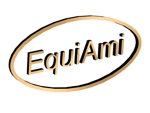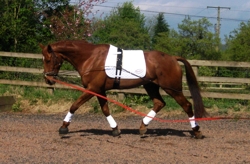Lungeing in equine therapy and rehabilitation
Many people are put off lungeing thinking it is boring, but it is only as boring as you make it, so how can you change this and how can lungeing work as therapy?
Twenty minutes of trotting round on the forehand or leaning on side reins achieves very little other than to compound old habits. Dr Hilary Bentley of EquiAmi says that lungeing, to be really effective, is best done with a lunge aid that encourages a horse to step under from behind and work into a soft, light contact whilst lifting their shoulders in order to develop balance and topline. Warming up and stretching for a few minutes at the start and cooling and stretching down at the end of the session are essential to prevent injury and stress on the joints.
There are however, concerns about the use of various ‘front-end’ devices as lunge aids, especially in relation to rehabilitation from Kissing Spine surgery and related issues.
In order to separate the spinous processes the back has to lift up. This can only be achieved when the horse increases the engagement from behind and steps further underneath his body with the hind feet. This then allows the forehand to lighten and lift and, if the horse is relaxed and not restricted, the head and neck can lower and soften leaving the withers as the highest point along the topline.
The horse’s core strength comes mainly from the Multifidus System; a network of crossing muscles that connect and stabilise the vertebrae, maintaining the gaps between them and preventing dipping. The biggest part of this muscular system is behind the withers where it is also supported by the Semispinalis and together, they provide lift for the back. The muscles of the hindquarters provide the power and propulsion to enable the lifting of the core hence the importance of ensuring engagement of the hindquarters during lungeing. Merely going along with the nose on the floor may look fine but is of no long-term use and the horse will tend to go on the forehand.
Coming back into work after injury, working a horse correctly is vital to achieving physical fitness and strength. Working over their backs and developing swing through a relaxed frame really enables the horse to open-up and step through from behind. Pole work, spiraling and transitions can be progressively used to good effect on the lunge once the horse is ready. Work closely with your vet or physiotherapist on the type of exercises your horse needs at each stage of rehabilitation and the results should be long term and sustained. The upside is that your horse’s progress is steady, monitored and visible. Small improvements lead on to bigger changes and many horses go on to become as good if not better than before and that is certainly not boring.
When lungeing you need to really look at the horse and ask yourself if he’s truly working through from behind and is he lifting his back - are his shoulders up? If not then you need to rethink the way you are lungeing. The EquiAmi lunge aid has been shown time and time again to be effective in promoting lifting of the back and, unless you have an exceptionally powerful and uphill horse, no front-end aid can achieve this.

Many vets and equine physiotherapists now recommend the EquiAmi lunge aid as it is so well tolerated and brings great results, whilst being easy to fit and use and at EquiAmi, we are available by telephone or email to provide assistance or to answer any questions you may have. Contact 01584 891049 or email This email address is being protected from spambots. You need JavaScript enabled to view it.
EquiAmi has a number of videos available - and this one shows a horse working in the lunge aid. Click the link to view now...... https://www.youtube.com/embed/odIqVgkvi_A




